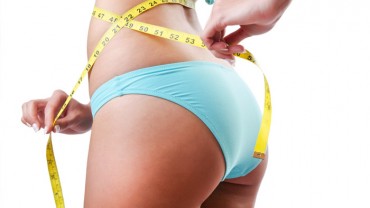How to Get Rid of Back Fat – Step-by-Step Guide
A strong, healthy back is essential to a strong healthy body.
Because we can see the extra fat we carry around our waist, it makes us want to do something about it.
However, we fail to consider the fat we carry on our backs.
This extra fat is often out of sight, out of mind.
We may not think of back fat until it appears as bulges on our sides or under our arms.
Why We Gain Back Fat
There are many reasons why we gain extra fat tissue on our backs.
Some of the reasons may be out of our control.
However, there are a few steps we can take to help reduce the amount of back fat or prevent it from accumulating.
In addition to the reasons why we gain back fat, this article will describe some exercises for back fat that we can do to help eliminate it, dietary changes we can make to help with losing back fat, and some of the do’s and don’ts we need to remember to help keep the back fat from returning.
Many people gain fat for medical reasons.
There may be side effects from certain medicines that cause weight gain.
Genetic conditions that run in families are unavoidable, but proper nutrition and exercise can help minimize their effects.
Poor nutrition habits and lack of physical activity are the most common reasons for weight gain, which can cause back fat.
Regardless of how you gained the weight that caused you to have back fat, you need to know how to get rid of it for a healthier and better-quality lifestyle.
A healthy lifestyle begins with having a healthy body weight.
You must consider the causes of weight gain when considering the solutions.
One consideration is the type of lifestyle you live.
Even if you are predisposed to gain weight because of genetics, you can limit the effect by practicing good nutritional habits and a regular exercise routine.
Think about where you spend most of your time and how active you are during the day.
Do you work indoors or outside? Do you have a job where you hardly move around during the day?
The amount of physical activity you do affects your metabolic rate.
If it is high you might lose weight, but if your rate is low, you will most likely gain weight, because your body is not burning stored sugar or body fat.
It is not just how much you eat that matters, but what you eat and drink.
The United States is a nation that lives on food from fast-food restaurants and processed foods containing a lot of additives and preservatives.
If you do not control the amount of sugar, sodium, calories, and carbohydrates from the food you eat, you will not be healthy.
Excessive weight gain and back fat appear when you eat too much of the wrong food.
Exercises to Reduce Back Fat
When it comes to reducing back fat, regular exercise goes hand in hand with good nutrition.
If you are going to lose weight, you must do some type of cardio exercise.
Cardio training three to four times per week will help you lose weight.
The most common types of gym equipment for cardiovascular training are the treadmill, elliptical trainer, and stationary bicycle.
In addition to cardio exercises, in order to lose weight, you should do high-intensity interval training (HIIT).
The back is a large body part, so it takes more than one type of exercise to develop it properly.
Your workout routine should include exercising both the upper back and lower back.
Listed below are the top ten back exercises to reduce back fat.
Seated Row
Sit and bend your knees a little.
Make sure your feet are firmly planted while keeping your abs tight and your chest high.
Without rounding your back, lean forward slightly to grasp the cable attachment.
Then forcefully contract your back muscles to pull the handle toward your waist.
Squeeze your shoulder blades together.
Hold the position and then release, while resisting the pull of the weight as you return to the start position.
To adjust the intensity, shorten or widen the distance between your hands on the bar.
Place your palms face down.
This adjustment will reduce the load on the latissimus dorsi and target the rear deltoids and rhomboid muscles.
Squeeze your shoulder blades together and pull the bar toward your chest, while keeping your elbows level with the bar.
The muscles developed with the seated row exercise are the following:
- Rhomboids major and minor
- Trapezius
- Latissimus dorsi
- Biceps brachii
- Brachialis
- Brachioradialis
- Teres major
- Teres minor
- Infraspinatus
- Posterior deltoid
Lat Pulldown
The lat pulldown will help improve the strength of your back.
The muscles targeted are the latissimus dorsi and the biceps.
Your hip flexors and abdominal muscles will also get a workout, as they help to keep you stable on the bench.
Other back muscles help control and retract the scapula.
The lat pulldown will also help improve your posture.
To perform this exercise, grab the bar. Place your thumbs just outside the bends in the bar.
Sit with your back straight on the seat. Place your thighs under the pads.
Then, pull the bar level with your chest. Keep a slight arch in your lower back.
Pause and then release under control. For a variation, use a rope attachment instead of the bar.
The muscle groups strengthened by the lat pulldown are the following:
- Teres major
- Latissimus dorsi
- Biceps brachii
- Brachialis
- Brachioradialis
- Posterior deltoid
Chin-up
With chin-ups, you build strength by lifting your own bodyweight.
The chin-ups will develop the back, shoulder, and arm muscles, in particular, the latissimus dorsi and the biceps.
Start with your hands on the bar and your palms facing your body.
Hang while bending your knees a little and keeping your head upright.
In one smooth motion, pull your body up until your chin is above the height of the bar.
Then gently lower your body, returning to the start position.
Make sure you extend your arms all the way when completing the chin-up.
A variation of this exercise is the pull-up.
You perform the pull-up in exactly the same way as the chin-up, except you place your palms away from your body.
The muscles strengthened by doing chin-ups are the following:
- Trapezius
- Posterior deltoid
- Teres minor
- Teres major
- Biceps brachii
- Brachialis
- Brachioradialis
- Latissimus dorsi
- Rhomboid major
- Rhomboid minor
Bent-Over Barbell Row
This free-weight exercise targets the muscles of the upper back while calling on the lower back and leg muscles to provide support.
It targets the latissimus dorsi, rear deltoid, infraspinatus, and biceps, while the erector spinae and hamstring muscles support the upper body.
The bent-over row is suitable for intermediate or advanced exercisers.
It is ideal for sports and occupations that require bending, lifting, or pulling.
You can do this exercise in the gym or at home because all you need is the floor space and a bar or dumbbells.
Grip the bar with your hands. The distance between them should be as wide as your shoulders.
Face your palms toward your body.
The distance between your feet should be the same as the distance between your shoulders.
Bend your knees slightly.
In the starting position, bend forward at the hips so the bar is just below the knees, with your back straight.
Pull the bar up to your ribs, while keeping your torso still and elbows close to your sides.
Lower the bar again in a smooth, controlled movement.
Use two dumbbells and grasp the weights with your palms facing each other.
This makes the grip for this exercise easier and allows the weight to move, without the knees getting in the way.
Pull the dumbbells up to your ribs, keeping your elbows close to your sides.
Lower the weight again in a smooth, controlled movement.
Perform the row with your hands spread apart and palms facing away from your body to target the latissimus dorsi and provide an extra challenge for your biceps.
Pull the bar up to your ribs, keeping your elbows close to your sides.
Extend your arms all the way out when you lower the bar.
Stand with your feet apart. The distance between your feet should be as wide as your shoulders.
Bend your knees a little. Bend forward at your hips.
You should be at about a 45-degree angle. Keep a slight arch in your lower back.
With a wide grip, grab the bar straight down in front of your legs.
Squeeze your shoulder blades together and pull the bar into your midsection.
Keep your elbows close to your body. Hold it, and then control the return.
The bent-over row develops the following muscles:
- Trapezius
- Infraspinatus
- Posterior deltoid
- Teres minor
- Teres major
- Biceps brachii
- Brachialis
- Brachioradialis
- Latissimus dorsi
- Rhomboids (under Trapezius)
Reverse Fly
This exercise targets the muscles of the upper back and shoulders.
The rear deltoid does most of the work with the help of the infraspinatus, teres minor, trapezius, and rhomboids.
You should do the reverse fly exercise at the end of your workout.
To perform this exercise, lie with your face down on a bench.
Make sure your back does not arch. Stand with your feet hip-width apart and knees bent.
Then lean forward at the hips, while keeping your back straight.
Instead of the dumbbells, use a low pulley cable for more of a challenge.
The reverse fly develops the posterior deltoid.
Single-arm Row
The single-arm row targets the latissimus dorsi, rear deltoids, and biceps.
Place your knee and hand on the supporting arm on a bench, so your torso is horizontal.
Place your other foot on the ground. Position it slightly back and to the side for stability.
Grasp the dumbbell with your palm facing toward the bench.
Pull the dumbbell up toward your body until it is at torso height, with your elbow brushing by the side of your body.
Extend your arms completely as you slowly lower the weight.
Lie with your face down on the bench if you are uncomfortable or feeling unstable in the kneeling position.
Make sure your back does not arch during the lift.
For an extra challenge, do this exercise while standing with your feet apart and knees bent.
Use a low pulley cable without any support for the opposite hand.
Remember not to rotate your torso to swing the weight up.
Also, keep your back straight during the lift, and look at the spot on the ground 4 feet in front of you.
The single-arm row develops the following muscles:
- Trapezius
- Posterior deltoid
- Teres major
- Brachialis
- Latissimus dorsi
- Rhomboids (under Trapezius)
Shrug
This exercise targets the back of the shoulders and the upper part of the back.
The upper fibers of the trapezius muscle do most of the work, with the levator scapulae assisting.
The shrug also gives the forearm muscles a great workout, as the relatively heavy load challenges the grip.
If you place one palm facing the body and one facing away, it allows a stronger grip on the bar and stops it from rolling out of your hands.
Pull the barbell straight up by elevating your shoulders toward the ears, keeping the bar close to your body.
Then, slowly lower the bar, returning to the start position.
The shrug develops the trapezius.
Bridge
The bridge targets the gluteal, hamstring, abdominal, and lower back muscles.
It is an excellent rehabilitation exercise to treat lower back pain and to increase core stability.
Lie back with your hands by your sides, knees bent, and feet on the floor.
Tighten the abdominal and gluteal muscles.
Push down on the heels and raise the hips to create a straight line from the knees to the shoulders.
Keep your core muscles tight, and do not let your hips drop or your back arch.
Hold this position for 20-30 seconds.
Once your muscles begin to fatigue, slowly lower yourself, returning to the start position.
Depending on your fitness level, lift your hips only a small way off the ground, or hold the standard position for a reduced amount of time.
For more difficulty, try a “one-legged bridge.”
The bridge develops the following muscles:
- Erector spinae
- Multifidus (under erector spinae)
- Rectus abdominis
- Internal oblique (under External oblique)
- External oblique
- Gluteus maximus
Back Extension
Use a back extension machine and place the pads underneath your thighs and on top of your calves.
Adjust the length to support your hips and pelvis, but do not support your upper body.
Start in a slightly hyperextended position, then lower your body, bending at the waist.
Lower as far down and as far back as your hamstring flexibility will allow.
Lift up and return to the starting position.
You can lie with your face down on the floor instead of using a machine.
Place your hands behind your back and arch up to lift your head, neck, shoulders, and chest off the ground.
You’ll get the same effect without using a machine.
The back extensions help to develop the following muscles:
- Erector spinae
- Multifidus
- Quadratus lumborum
(1, 2, and 3 all under Thoracolumbar fascia)
Upright Row
This exercise targets the lateral deltoids.
The anterior deltoid, trapezius, and biceps muscles also assist during the lift, while the lower back muscles provide support to the upper body.
Stand with your feet apart. Bend your knees a little. Grab hold of the barbell.
Face your palms toward your body with your arms extended.
Bend your elbows and pull the barbell straight up, while keeping the bar close to your body.
Your elbows should be level with your shoulders. Allow your wrists to flex as the bar rises.
Slowly lower the bar, returning to the start position.
Do this exercise one side at a time using a dumbbell.
Grab a dumbbell in one hand and hold on to a solid stationary object for support with your other hand.
Use the same technique and body position as the standard upright row, ensuring your elbows point out to the side.
Using two dumbbells instead of one will add extra instability, which will require you to maintain greater control.
Grab hold of the dumbbells. Face your palms toward your body. Keep your arms extended.
Bend your elbows and pull the dumbbell straight up, while keeping the weight close to your body.
Your elbows should be level with your shoulders.
Raise the dumbbells just below your shoulders. Keep your elbows pointed out to the sides.
The upright row exercise helps to develop the following muscles:
- Lateral deltoid
- Biceps brachii
- Brachioradialis
- Trapezius
- Supraspinatus (under Trapezius)
Dietary Changes to Lose Back Fat
The minimum recommended daily calorie intake for women who are dieting is 1,200 calories, and for men is 1,800 calories.
You should stay away from any fad diet that requires you to eat any less than that.
These diets will be hard to maintain for more than a few days.
You will not consume enough calories to fuel your body, which will cause your metabolism to burn muscle instead of fat.
You can try just about any diet and you will lose weight.
The question is, will you keep it off? You want to lose weight, but you also want to be healthy.
If you want to lose weight the proper way, you should choose a diet plan that focuses on eating a well-balanced meal.
Your diet should include whole, unprocessed foods.
You should also include a healthy portion of lean protein, low-fat dairy, whole grains, fruit, vegetables, and unsaturated fats.
It is all right to reduce the amount of food you eat, but do not cut out any one particular food group altogether.
It is not that certain foods are bad for us; it is that we do not eat them in the correct portions.
There is no one way to prevent your body from gaining weight in your back.
The only thing you can do is to keep from gaining extra weight generally.
You can lose weight by eating fewer calories.
Ultimately, you do want to eat fewer calories than you burn every day in order to lose weight.
A realistic goal is to reduce your calorie intake by 250 to 500 calories per day.
A calorie deficit of 500 to 1,000 calories per day allows you to lose 1 to 2 pounds of weight per week.
One pound of fat equals 3,500 calories.
If we stop to consider this fact, it may help us to make better choices about what we eat during the day.
Fad diets either do not work, or you will not be able to sustain the weight loss.
To make sure you eat enough food to help you feel full, you should eat the daily recommended amount of lean protein.
This will also prevent you from losing muscle mass.
Seeing the numbers go down on the scale does not always equal success.
You could weigh less because you have lost muscle mass instead of fat.
Practice portion control and eating fewer calories by consuming more green vegetables, fruit, and whole grains.
Be aware of your daily nutritional distribution of protein, carbohydrates, fiber, sugars, and fat, but understand that you will not be able to eat an exact ratio of any one category.
The amount of protein you need per day depends on your body weight.
Rather than trying to maximize or limit the amount of protein or other nutrients, it is better to eat a well-balanced diet for healthy weight loss.
You should eat lean protein, healthy fats, and plenty of fruits and vegetables.
Eliminate the empty calories from your diet.
Empty calories come from foods that taste good or are used for emotional eating but do not add any nutritional value to your diet.
They are items such as sugary sodas, candy, and potato chips.
Eating these will either slow down your weight loss or cause you to gain weight.
It is important to make small changes each day rather than trying to do away with all of your bad habits at once.
It will be easier to maintain the healthy habits if you introduce one new one each week.
For example, you can start one week by drinking more water and less sugary sodas.
The next, you can add more fruit to your daily diet.
Extra fat around your waist could make you self-conscious of how you look and the way your clothes fit.
Unfortunately, when you gain weight body fat will accumulate in areas where you do not want it to.
As you lose weight back fat will disappear all over, not in just one area.
This is the reason why we emphasize a total weight loss program.
The focus must be on eating healthy portions of the whole, unprocessed foods while doing exercise that works your muscles.
Make sure your exercise routine includes both cardiovascular exercises and strength-training.
Lower back is most likely tissue fat sitting under the skin.
It can be one of the most difficult kinds of fat to lose.
Not only is it unsightly, it can be annoying, and affect your self-esteem.
However, it is not as dangerous as the fat in your mid-section.
Although exercise is essential to weight loss, there are no specific exercises that burn off more back fat than others.
You should concentrate on burning off calories through cardiovascular exercise to contribute to your calorie deficit to lose pounds.
According to the American College of Sports Medicine, you should do at least 250 minutes of cardio exercise each week to lose any significant amount of weight.
At first, you will notice changes in the reduction of visceral fat.
Then, you will start to burn fat from your waistline and back.
High-intensity interval training should be included in your exercise routine.
High-intensity interval training will help your body burn fat more effectively.
Even though there aren’t any particular exercises to target back fat, an exercise routine that works all of the muscles in your body will help build more muscle overall.
Building more muscle will help increase your metabolism because muscle requires more energy to sustain than fat.
Therefore, train all of the major muscle groups at least twice a week.
You should do a minimum of one set of eight to 12 repetitions of all exercises, increasing the resistance until you reach the last set.
Doing cardiovascular exercise like the ones mentioned earlier will help you keep from gaining body fat, which obviously will keep the fat off of your back.
Working with weights alone will not help you lose the weight.
You must introduce at least seventy-five minutes of vigorous intense cardio training weekly.
If you are healthy enough and want to see results faster, you should increase the cardio workout time to 300 minutes a week.
Finally, there is no substitute for strengthening and toning your muscles.
Exercise at least two or three times a week, while challenging all of your major muscles.
If you do this, you can help prevent back fat from accumulating.
For people who may be extremely obese, your physician may recommend other methods of getting rid of the weight in addition to exercise and diet.
It may be necessary to change the medication you’re taking if it is causing you to gain fat.
Your doctor will either alter your dose or switch your medication to something that will not cause the same effect.
In certain cases, your doctor may even recommend surgery.
One treatment for fat removal is liposuction, which has helped some patients.
For the back, tumescent liposuction is the safest.
Some liposuction procedures can leave the skin permanently discolored or with bumps that were not there before the surgery.
In these instances, the patient will have to consult a plastic surgeon if they want them removed.
The only way to lose either type of fat is through a comprehensive weight-loss strategy.
No one plan can reduce fat around your waist or on your back.
The fat will disappear when you eat less and exercise.
Your body will convert the stored fat to usable energy, and you will lose weight.
Again, the weight loss will not be in just one area, but from all over your entire body.
Visceral fat may come off first, and the back fat will come off over a period of time.
How to Prevent Getting Back Fat
As stated earlier, there are many reasons why we gain extra fat tissue on our body, and unfortunately, some of it ends up on our backs as back fat.
Medicine and genetics can make it difficult to prevent weight gain, but not impossible.
You can work to control the amount of weight gained by not overeating, and by exercising.
Think about what you do, where you spend most of your time, and how active you are during the day.
Do your work indoors or outside?
Do you have a job where you hardly move around during the day?
The amount of physical activity you do affects your metabolism. If your body uses energy, you will lose weight.
If your metabolic rate is slow, you will most likely gain weight, because your body is not using energy to burn stored sugar or body fat.
If you develop good habits in the beginning and stick with them, it will help reduce your chances of ever having to deal with back fat.
It will be much easier than having to lose the back fat once you’ve gained it.
Many people start out in life with a good exercise routine when they are young.
They may have been involved in sports during high school that allowed them to get in good physical shape.
Then they may have joined the military or become employed in a job where physical conditioning was a requirement.
Once they graduated or left that job, the good habits they once had may have slipped away, because it was no longer a requirement.
There was no one telling them to go out and exercise.
So, they became overweight and ended up with back fat.
Sadly, that is the story of too many.
The fact is that it should not be necessary to have someone else make you eat right and exercise.
Every individual must develop the mindset to do those things on their own.
You only live for yourself, and you only live once. It is your health that is at stake.
You can join a gym, get a fitness trainer, or consult a dietician to help, but none of those people can lose the weight for you.
Ultimately, it is your decision. You must consider what type of lifestyle you want to live.
You can practice good nutritional habits and have a regular exercise routine.
Not gaining back fat is easier than trying to find out how to lose it.
Do’s and Don’ts
How to get rid of back fat? The answer is one step at a time.
Here are some of the dos and don’ts when it comes to losing back fat.
Don’ts:
- Develop bad eating habits.
- Eat an excessive amount of fast food and processed foods.
- Consume empty calories.
- Try fad diets that prohibit you from eating an entire food group.
- Don’t eat fewer than 1,200 calories when dieting if you are a woman, or fewer than 1,800 calories if you are a man.
- Don’t get discouraged with your efforts because it’s taking longer than you thought it would.
- Ignore pain when exercising.
Do’s:
- Control your daily intake of sugar, sodium, calories, and carbohydrates.
- Eat a balanced diet with the proper nutrition.
- Eat fewer calories.
- Get active. Exercise daily.
- Get plenty of rest so your muscles can recover.
- Consult your physician before beginning any new exercise routine.
- Do at least 75 minutes of cardio training each week.
- Do strength and conditioning training.
- Do the type of strength and conditioning exercises that will affect the area of the back you want to work on.
- Follow instructions and maintain proper technique when exercising.
- Maintain a positive attitude.
Conclusion
The best way to get rid of back fat is not to have it in the first place.
If you practice good habits with nutrition and exercise, body fat should not be an issue, unless there are other reasons such as medical or genetic ones that cause you to gain weight.
How to lose back fat once you have gained it will be the same way you lose fat in any other area of your body.
There is no one exercise or particular diet geared towards losing back fat.
The key is cardiovascular exercise, strength and conditioning exercises, and good nutrition.
FDA Compliance
The information on this website has not been evaluated by the Food & Drug Administration or any other medical body. We do not aim to diagnose, treat, cure or prevent any illness or disease. Information is shared for educational purposes only. You must consult your doctor before acting on any content on this website, especially if you are pregnant, nursing, taking medication, or have a medical condition.
HOW WOULD YOU RATE THIS ARTICLE?






